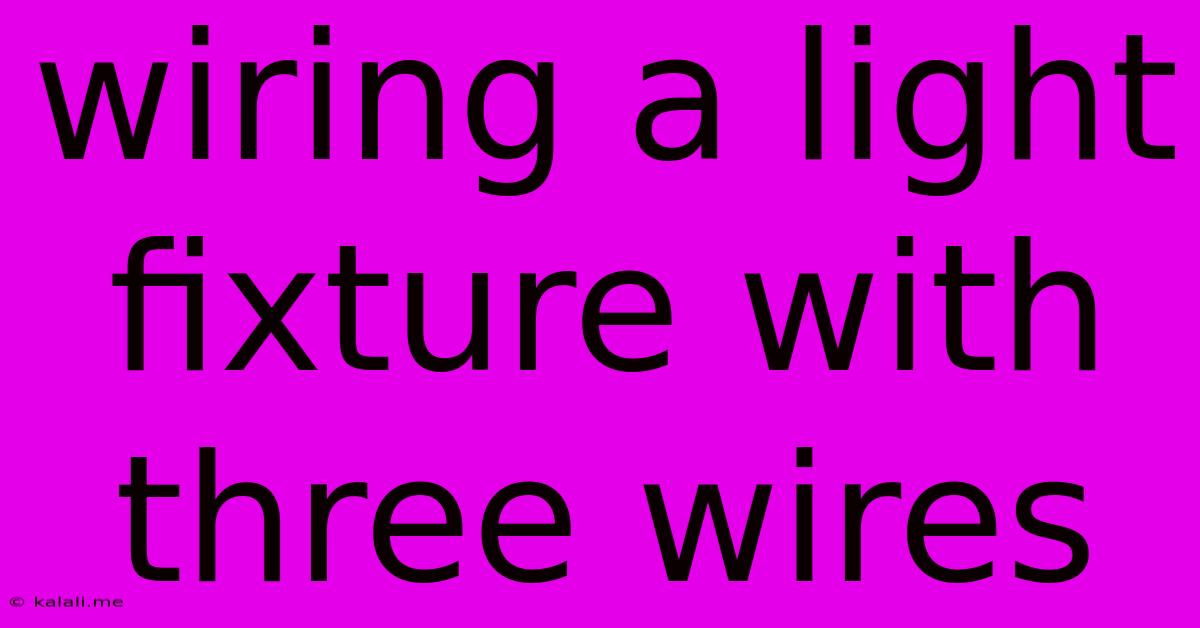Wiring A Light Fixture With Three Wires
Kalali
May 31, 2025 · 3 min read

Table of Contents
Wiring a Light Fixture with Three Wires: A Comprehensive Guide
Meta Description: Learn how to safely wire a three-wire light fixture. This comprehensive guide covers identifying wires, connecting them correctly, and ensuring electrical safety. Perfect for DIY homeowners tackling home lighting projects.
Wiring a light fixture might seem daunting, but with the right knowledge and careful attention, it's a manageable DIY project. This guide focuses specifically on wiring a light fixture with three wires, a common scenario in many homes. Understanding the color codes and proper connections is crucial for both functionality and safety.
Identifying the Wires
Before you begin, always turn off the power at the breaker box. This is the most important safety precaution to prevent electric shock. Once the power is off, you can safely identify the wires in your light fixture and the junction box. You should find three wires in both locations:
- Black (Hot): This wire carries the electrical current to the fixture.
- White (Neutral): This wire completes the electrical circuit, returning the current to the power source.
- Ground (Bare Copper or Green): This wire provides a path for stray electrical current to safely flow to the ground, preventing shocks.
Connecting the Wires
Once you've identified the wires, connect them correctly using wire connectors (also known as wire nuts). Match the colors:
- Black to Black: Connect the black (hot) wire from the fixture to the black (hot) wire from the junction box.
- White to White: Connect the white (neutral) wire from the fixture to the white (neutral) wire from the junction box.
- Ground to Ground: Connect the bare copper or green ground wire from the fixture to the bare copper or green ground wire from the junction box. If your junction box doesn't have a ground wire, you may need to install a ground wire according to local electrical codes. This is crucial for safety.
Important Note: Ensure that all wire connectors are tightly secured. Loose connections can lead to overheating and potential fire hazards. Use appropriately sized wire connectors for the number of wires you're joining.
Testing and Securing the Fixture
After making the connections, carefully tuck the wires back into the junction box. Secure the light fixture to the electrical box using the mounting hardware provided. Always double-check your connections before turning the power back on.
Turn the power back on at the breaker box. If the light fixture works correctly, you've successfully wired it. If not, double-check all your connections and ensure the power is off before making any adjustments.
Troubleshooting Common Issues
If your light fixture isn't working, here are some common problems to check:
- Loose Connections: Recheck all wire connections to ensure they are tight and secure.
- Incorrect Wiring: Double-check that you've connected the wires according to the color codes.
- Burned-Out Bulb: Replace the bulb with a known good one to rule out a simple bulb failure.
- Faulty Fixture: If you've checked everything and the light still doesn't work, the fixture itself might be faulty.
Safety First!
Remember, electrical work can be dangerous. If you're not comfortable working with electricity, it's always best to consult a qualified electrician. This guide provides general information and should not be considered a substitute for professional electrical advice. Always prioritize safety and adhere to local electrical codes. Improper wiring can lead to electrical fires and severe injury.
Latest Posts
Latest Posts
-
How To Wire 220 Plug With 3 Wires
Jun 02, 2025
-
How To Get A Stripped Bolt Off
Jun 02, 2025
-
Tables Manage User Best Practice For Mobile Ux Design
Jun 02, 2025
-
Why Is Furnace Blowing Cold Air
Jun 02, 2025
-
How To Get Rid Of Kitchen Sink Odor
Jun 02, 2025
Related Post
Thank you for visiting our website which covers about Wiring A Light Fixture With Three Wires . We hope the information provided has been useful to you. Feel free to contact us if you have any questions or need further assistance. See you next time and don't miss to bookmark.